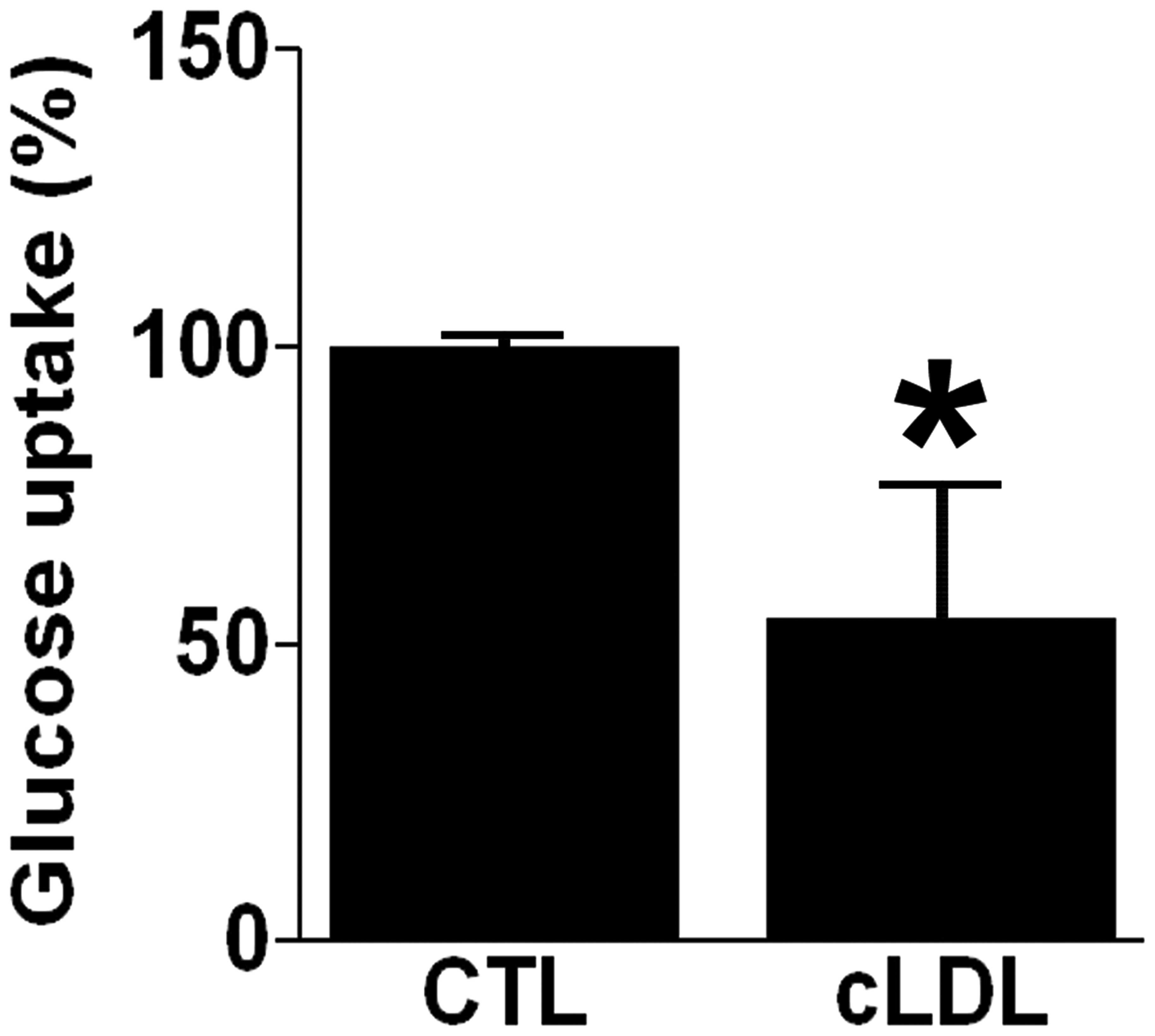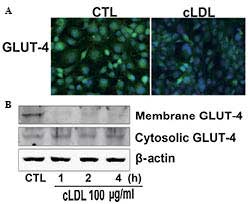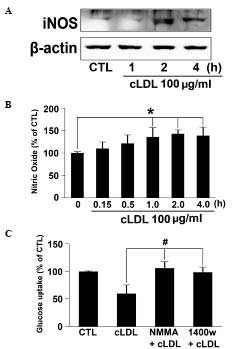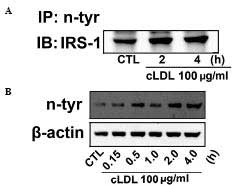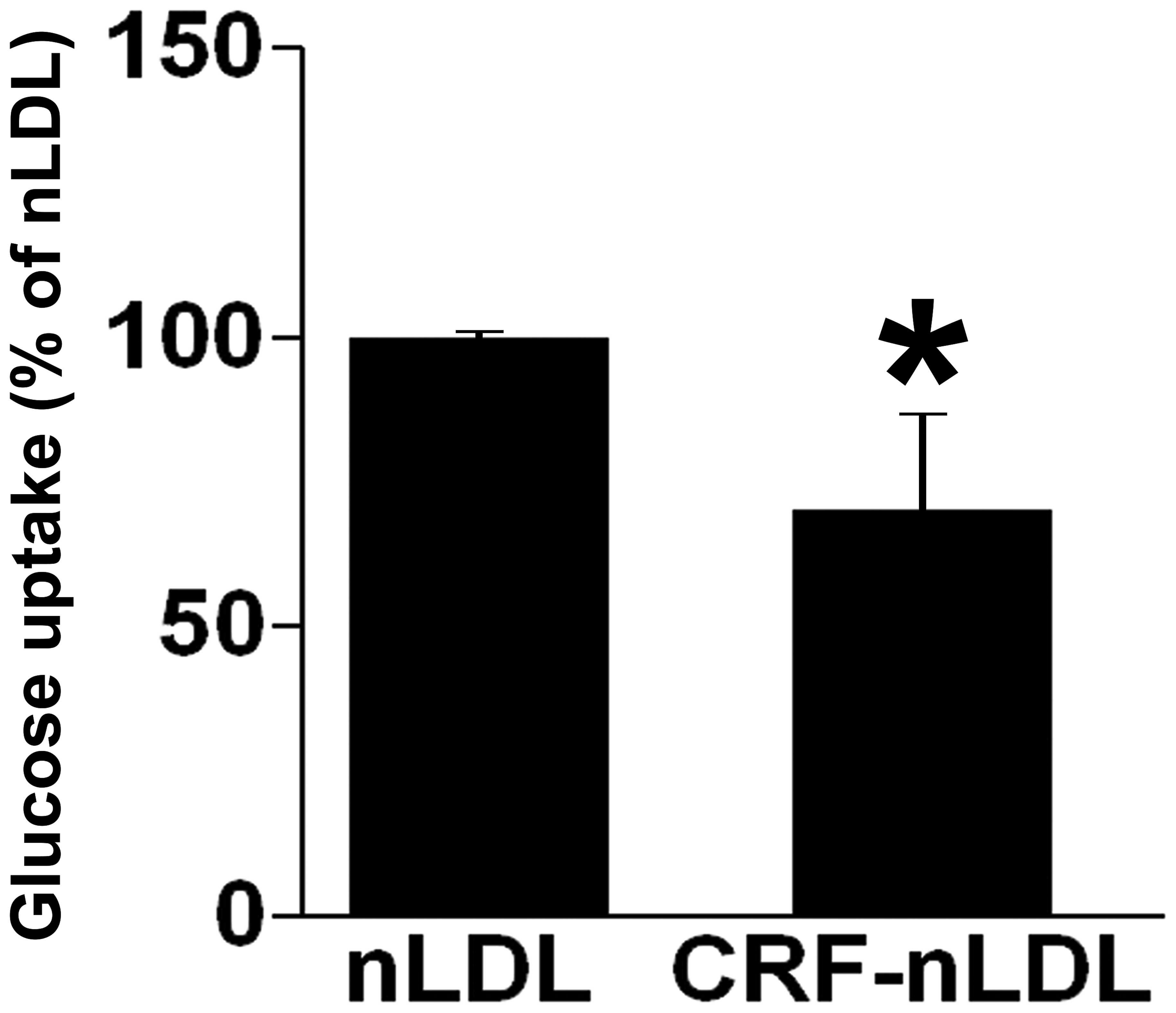Carbamylated low-density lipoprotein attenuates glucose uptake via a nitric oxide-mediated pathway in rat L6 skeletal muscle cells
- Authors:
- Published online on: March 13, 2015 https://doi.org/10.3892/mmr.2015.3481
- Pages: 1342-1346
Abstract
Introduction
Carbamylation is a posttranslational modification of proteins induced by cyanate in human blood plasma (1). The active form of cyanate, isocyanic acid, reacts irreversibly with the amino- or thiol groups of amino acids in proteins. The resulting in vivo carbamylation changes the structure of proteins, and modifies the activity of enzymes, cofactors, hormones and antibodies (2).
Several carbamylated proteins have been reported. Carbamylated erythropoietin protects the kidneys from cyclosporine-induced nephropathy (3) and astrocyte swelling induced by ischemia and reperfusion-like injury (4). Carbamylated albumin decreased O2-production in polymorphonuclear neutrophils (5). Our group previously reported that carbamylated low-density lipoprotein (cLDL) increases reactive oxygen species (ROS) and apoptosis via the lectin-like oxidized LDL receptor-mediated pathway in human umbilical vein endothelial cells (6).
Carbamylation of low-density lipoprotein (LDL) has thus far been investigated predominantly in the context of uremia (7,8) as urea spontaneously converts to cyanate and ammonia in aqueous solutions (1). However, a recent study demonstrated that thiocyanate, elevated by smoking and diet, is changed into cyanate in human blood plasma (9). The reaction is catalyzed by myeloperoxidase (MPO), a heme protein derived from leukocytes. MPO-catalyzed carbamylation attenuates LDL receptor recognition of LDL and raises scavenger receptor recognition of LDL leading to cholesterol accumulation in macrophages and foam-cell formation. Increased levels of MPO are also associated with type 1 and 2 diabetes mellitus (DM) (10,11).
Skeletal muscle is key in glucose homeostasis (12). The removal of excess glucose from the circulation involves the stimulation of glucose transport into skeletal muscle tissue, and glucose intolerance in type 2 diabetes mellitus (T2DM) is associated with defects in this glucose transport process, which is regulated predominantly by insulin. Glucose transporter 4 (GLUT4) deficiency is involved in impaired glucose uptake in skeletal muscle (13,14).
In this study, it was examined whether cLDL has biologic effects that are relevant to DM. Thus, the present study was designed to determine the effects of cLDL using cultured L6 skeletal muscle cells.
Materials and methods
Cell culture
L6 myoblasts (American Type Culture Collection, Manassas, VA, USA) were maintained in Dulbecco’s modified Eagle’s medium (DMEM) supplemented with 10% (v/v) fetal bovine serum and 1% streptomycin and penicillin (all from; Gibco Life Technologies, Carlsbad, CA, USA) under an atmosphere of 5% CO2 and 95% humidified air at 37°C. The cells were grown for 4 days to form myotubes in DMEM supplemented with 2% horse serum (Gibco Life Technologies). The medium was renewed every 2 days.
Carbamylation of LD
Plasma samples from 3 healthy subjects and 5 patients with chronic renal failure (CRF) who underwent routine dialysis at the Dongsan Medical Center (Daegu, Republic of Korea) between 2001 and 2004 were obtained. LDL was prepared as previously described [Horkko et al 1992]. Briefly, LDL was isolated by ultracentrifugation at 4°C at 250,000 × g for 22 h, yielding LDL at a final density of 1.019–1.063 g/ml in sodium chloride. The isolated LDL was dialyzed, for 24 h against 1 mM EDTA, pH 8.0. The dialyzed LDL was termed native LDL (nLDL). The nLDL concentration was determined by the Bradford protein assay (BioRad, Hercules, CA, USA). Potassium cyanate was added to the nLDL at 20 mg per mg of nLDL protein and the mixture was incubated at 37°C for 4 h. Excessive reagents were removed by dialysis for 36 h in sterile conditions at 4°C against 0.15 M NaCl and 0.01% EDTA, pH 7.0. The modification of the net charge of cLDL was assessed by 0.5% agarose gel electrophoresis, as previously described (15).
Glucose uptake assay
The L6 myotubes were cultured on 6-well culture plates, washed with Krebs-Ringer phosphate-HEPES (KRBH) buffer [containing 10 mM Na2HPO4, 1 mM MgSO4, 1 mM CaCl2 136 mM NaCl, 4.7 mM KCl, 10 mM HEPES, pH 7.4; and 0.2% bovine serum albumin (BSA)] and treated with 20 ng/ml insulin or 100 μg/ml cLDL. Glucose uptake was measured by adding 0.5 μCi/ml 2-[3H]-deoxy-d-glucose followed by incubation for 20 min at 37°C. The reaction was terminated by washing the cells three times with ice-cold phosphate-buffered saline (PBS). Cells were subsequently lysed with 1 M NaOH solution. Cell associated radioactivity was measured in a liquid scintillation counter (Beckman Coulter, Brea, CA, USA).
Immunofluorescence microscopy
L6 myotubes were grown on glass coverslips in a 12-well plate and were fixed with 4% paraformaldehyde in PBS for 10 min and permeabilized with 0.25% Triton X-100 (Sigma-Aldrich, St. Louis, MO, USA) in PBS for 5 min. Cells were blocked with 2% BSA in PBS at room temperature (RT) for 1 h, prior to incubation with primary antibody at 4°C overnight. The primary antibodies were as follows: Polyclonal rabbit anti-GLUT4 (sc-7938; Santa Cruz Biotechnology, Inc., Santa Cruz, CA, USA), and monoclonal mouse anti-β-actin (A5441; Sigma-Aldrich). Fluorescein-conjugated goat anti-rabbit IgG-HRP (sc-2004; Santa Cruz Biotechnology, Inc.) was used as the secondary antibody. Nuclear staining was performed with 4′,6-Diamidino-2-phenylindole dihydrochloride (DAPI; Invitrogen Life Technologies, Carlsbad, CA, USA) at RT for 15 min. The slides were mounted and analyzed by fluorescent microscopy (Zeiss Axiovert 200M; Zeiss, Jena, Germany).
Preparation of plasma membrane from L6 myotubes
L6 myotubes were harvested with 0.25 M sucrose and homogenated with 26-gauge needle. The homogenate was centrifuged at 600 x g for 10 min at 4°C and the supernatant was centrifuged at 10,000 × g for 20 min at 4°C. The supernatant was centrifuged at 140,000 × g for 60 min at 4°C. The supernatant was collected and stored as a cytosolic fraction at −70°C until analyses. The precipitate obtained was suspended again in 0.25 M sucrose and stored as a membrane fraction.
Western blot analysis
L6 myotubes were washed twice with cold PBS and then lysed in ice-cold radioimmune precipitation assay (RIPA) buffer (pH 7.4; 50 mM Tris-HCl, 25 mM EDTA, 650 mM NaCl and 5% Triton X-100) containing protease inhibitors cocktail solution (Promega Corporation, Madison, WI, USA). The lysates were centrifuged for 20 min at 12,000 x g at 4°C and the supernatant was collected. The proteins were separated by SDS-PAGE and transferred to nitrocellulose membrane (GE Healthcare Life Sciences, Chalfont, UK). The membrane was blocked in 5% skimmed milk in Tris-buffered saline plus 0.1% Tween 20 (TBS-T) prior to incubation for 1 h at RT with primary antibodies. The primary antibodies were as follows: Polyclonal rabbit anti-GLUT4 (sc-7938; Santa Cruz Biotechnology, Inc.), polyclonal rabbit anti-iNOS (06-573; EMD Millipore, Billerica, MA, USA), monoclonal mouse anti-nitrotyrosine (sc-32757; Santa Cruz Biotechnology, Inc.), polyclonal rabbit anti-insulin receptor substrate-1 (IRS-1; sc-559; Santa Cruz Biotechnology, Inc.) and monoclonal mouse anti-β-actin (A5441; Sigma-Aldrich). The membrane was then washed in TBS-T and incubated with horseradish peroxidase-conjugated goat anti-rabbit or anti-mouse IgG-HRP secondary antibodies (Santa Cruz Biotechnology, Inc.). Protein bands were detected using enhanced chemiluminescensce reagents (GE Healthcare Life Sciences, Piscataway, NJ, USA).
Nitric oxide (NO) production
NO production was determined spectrophotometrically using Griess reagent [1% (w/v) sulfanilamide and 0.1% (w/v) naphthylethylenediamine dihydrochloride in 2.5% phosphoric acid]. The Griess reagent was added to samples of the incubation medium, and the absorption was read at 540 nm (VICTOR3; PerkinElmer, Waltham, MA, USA).
Immunoprecipitation
Cell lysates were immunoprecipitated with an anti-nitrotyrosine antibody coupled to protein A/G plus agarose overnight at 4°C. The immune complex was washed three times in PBS, resuspended in RIPA buffer, and boiled for 5 min. Proteins were resolved on SDS-PAGE and processed for western blot analysis.
Statistical analysis
Data are shown in terms of relative values and presented as the mean ± standard deviation. Multi-group comparisons were conducted by Student’s t-test with SPSS, version 18.0 (SPSS, Inc., Chicago, IL, USA). P<0.05 was considered to indicate a statistically significant difference.
Results
cLDL decreases glucose uptake
Glucose uptake was determined in differentiated L6 myotubes after incubation with 100 μg/ml cLDL. It was demonstrated that glucose uptake was decreased in cLDL-treated L6 myotubes by 54±22% relative to control (P<0.05, Fig. 1). The effect of oxidized LDL (oxLDL) on glucose uptake was also observed and it was found that oxLDL did not affect glucose uptake in differentiated L6 myotubes (data not shown).
cLDL stimulates GLUT-4 translocation
Cells were incubated with cLDL for the indicated time and investigated for GLUT-4 translocation using immunofluorescence and immunoblot analysis. It was observed that cLDL treatment decreased the fluorescence intensity of GLUT-4 in L6 myotubes compared with that of the control (Fig. 2A). It was also observed that cLDL treatment attenuated the expression of GLUT-4 in the plasma membrane of myotube cells while increased the expression of GLUT-4 in the cytosol of myotube cells (Fig. 2B).
cLDL increases NO mediated tyrosine nitration of IRS-1
L6 myotubes were incubated with cLDL (100 μg/ml) for the indicated times and iNOS expression was determined via western blot analysis. Expression of iNOS in cells treated with cLDL were noticeably increased at 1 h and maintained at 4 h (Fig. 3A). NO production in the media of cLDL-treated L6 myotubes also increased in a time dependent manner (Fig. 3B). Significantly increased quantities of NO at 1, 2, and 4 h of cLDL incubation (P<0.05) were observed. In order to determine whether cLDL attenuates glucose uptake via NO production, NMMA and 1400 W, specific inhibitors of NOS were employed, and it was observed that treatment with NMMA or 1400 W reversed the inhibitory effect of cLDL on glucose uptake in L6 cells (Fig. 3C).
To gain further understanding molecular mechanism underlying the effect of cLDL-induced NO production on the tyrosine nitration of IRS-1 was determined by immunoprecipitation and western blot analysis was examined. An increase in tyrosine nitration of IRS-1 in cLDL treated L6 cells (Fig. 4A) was observed. In addition, cLDL treatment was shown to increase levels of protein tyrosine nitration in a time-dependent manner (Fig. 4B).
LDLs derived from patients with CRF decrease glucose uptake
The effects of LDLs derived from patients with CRF on glucose uptake were next investigated in L6 cells compared with native LDLs (nLDL) derived from healthy subjects. Exposure of L6 myotubes to CRF-nLDL for 4 h markedly reduced glucose uptake by 70±16% compared with nLDL (Fig. 5).
Discussion
While oxLDL is the modified LDL that has been most extensively investigated (16), little is known regarding the functions of cLDL, the most abundant isoform of modified LDL in the plasma (17). In the current study, it was hypothesized that cLDL may be involved in glucose metabolism in muscle cells based on our previous study, which demonstrated that cLDL increases ROS in endothelial cells (6). Indeed, it was shown that cLDL attenuates glucose uptake in skeletal muscle cells and the inhibitory effect of cLDL on glucose uptake is mediated via an NO mediated pathway.
Carbamylation of protein has been considered quantitatively important only in the presence of chronic renal disease as urea is hypothesized to be the endogenous source of cyanate (8). Thus, uremia-induced carbamylation of protein presents an important risk factor for the development of cardiovascular disease. Studies proved that cLDL is also involved in the pathogenesis of atherosclerosis (9,18,19). Exposure of endothelial cells to cLDL induces expression of adhesion molecules and stimulates vascular muscle cell proliferation (20–22). Our group also previously reported that cLDL induced increases in ROS and apoptosis in endothelial cells (6).
A recent study determined that MPO-mediated protein carbamylation is a uremia-independent mechanism for the synthesis of cLDL (9). MPO mediates the production of cyanate from the substrates thiocyanate and H2O2. Another recent study reported increased plasma levels of cLDL and MPO in patients with T2DM even in the absence of renal impairment (23). In keeping with these findings, results of the current study indicated that cLDL attenuated glucose uptake in skeletal muscle cells.
In this study, the effects of cLDL on glucose transport were explored in skeletal muscle cells. It was demonstrated that cLDL alone markedly attenuated glucose uptake in myotube cells. Since skeletal muscle is responsible for the majority of glucose disposal, the inhibitory effect of cLDL on glucose transport suggests a possible role for cLDL in the development of T2DM. GLUT4 translocation from the cytosol to the membrane is the rate-limiting step for glucose transport and is associated with insulin resistance (12,13,24). It was observed that cLDL decreased GLUT4 expression in the membrane while increased it in the cytosol.
A previous study demonstrated that iNOS induction is linked to impaired insulin-stimulated glucose uptake in skeletal muscles (25). Genetic deletion of iNOS protects against high-fat diet-induced insulin resistance (26). iNOS-derived NO induces tyrosine nitration of IRS-1 and is associated with insulin resistance (27). In this study, cLDL treatment markedly induced the expression of iNOS in L6 cells and increased NO production. Co-treatment of 1400 W or NMMA, selective iNOS inhibitors, reversed cLDL-attenuated glucose transport. These results indicate that the inhibitory effect of cLDL on glucose transport is mediated via the iNOS pathway. To confirm the effect of cLDL on glucose transport, myotube cells were treated with nLDL from healthy subjects or CRF-nLDL and found that LDL derived from patients with CRF decreased glucose uptake in L6 cells compared with that from healthy subjects.
In conclusion, the present results suggest that cLDL is involved in the development of T2DM via induction of NO in muscle cells. These results also provide insights into the as yet unidentified functions of cLDL in relation to T2DM.
Acknowledgments
This study was supported by the Kidney Institute Research Grant of Keimyung University in 2010 and the National Research Foundation of Korea (NRF) funded by the Korean Government (MSIP) (grant no. 2014R1A5A2010008).
References
|
Ha E: Cyanate attenuates insulin secretion in cultured pancreatic β cells. Mol Med Rep. 5:1461–1464. 2012.PubMed/NCBI | |
|
Ok E, Basnakian AG, Apostolov EO, et al: Carbamylated low-density lipoprotein induces death of endothelial cells: a link to atherosclerosis in patients with kidney disease. Kidney Int. 68:173–178. 2005. View Article : Google Scholar : PubMed/NCBI | |
|
Abe T, Isaka Y, Imamura R, et al: Carbamylated erythropoietin ameliorates cyclosporine nephropathy without stimulating eryth-ropoiesis. Cell Transplant. 21:571–580. 2012. View Article : Google Scholar | |
|
Tang Z, Sun X, Shi Q, et al: Beneficial effects of carbamylated erythropoietin against oxygen-glucose deprivation/reperfusion-induced astrocyte swelling: proposed molecular mechanisms of action. Neurosci Lett. 530:23–28. 2012. View Article : Google Scholar : PubMed/NCBI | |
|
Jaisson S, Delevallée-Forte C, Touré F, et al: Carbamylated albumin is a potent inhibitor of polymorphonuclear neutrophil respiratory burst. FEBS Lett. 581:1509–1513. 2007. View Article : Google Scholar : PubMed/NCBI | |
|
Son JN, Lho Y, Shin S, et al: Carbamylated low-density lipoprotein increases reactive oxygen species (ROS) and apoptosis via lectin-like oxidized LDL receptor (LOX-1) mediated pathway in human umbilical vein endothelial cells. Int J Cardiol. 146:428–430. 2011. View Article : Google Scholar | |
|
Hörkkö S, Huttunen K, Kervinen K, et al: Decreased clearance of uraemic and mildly carbamylated low-density lipoprotein. Eur J Clin Invest. 24:105–113. 1994. View Article : Google Scholar : PubMed/NCBI | |
|
Kraus LM and Kraus AP Jr: Carbamoylation of amino acids and proteins in uremia. Kidney Int Suppl. 78:S102–S107. 2001. View Article : Google Scholar : PubMed/NCBI | |
|
Wang Z, Nicholls SJ, Rodriguez ER, et al: Protein carbamylation links inflammation, smoking, uremia and atherogenesis. Nat Med. 13:1176–1184. 2007. View Article : Google Scholar : PubMed/NCBI | |
|
Heilman K, Zilmer M, Zilmer K, et al: Arterial stiffness, carotid artery intima-media thickness and plasma myeloperoxidase level in children with type 1 diabetes. Diabetes Res Clin Pract. 84:168–173. 2009. View Article : Google Scholar : PubMed/NCBI | |
|
Wiersma JJ, Meuwese MC, van Miert JN, et al: Diabetes mellitus type 2 is associated with higher levels of myeloperoxidase. Med Sci Monit. 14:CR406–CR410. 2008.PubMed/NCBI | |
|
Moller DE: New drug targets for type 2 diabetes and the metabolic syndrome. Nature. 414:821–827. 2001. View Article : Google Scholar : PubMed/NCBI | |
|
Yea K, Kim J, Yoon JH, et al: Lysophosphatidylcholine activates adipocyte glucose uptake and lowers blood glucose levels in murine models of diabetes. J Biol Chem. 284:33833–33840. 2009. View Article : Google Scholar : PubMed/NCBI | |
|
Fam BC, Rose LJ, Sgambellone R, et al: Normal muscle glucose uptake in mice deficient in muscle GLUT4. J Endocrinol. 214:313–327. 2012. View Article : Google Scholar : PubMed/NCBI | |
|
Ha E, Bang JH, Son JN, et al: Carbamylated albumin stimulates microRNA-146, which is increased in human renal cell carcinoma. Mol Med Rep. 3:275–279. 2010. | |
|
Lautamäki R, Rönnemaa T, Huupponen R, et al: Low serum adiponectin is associated with high circulating oxidized low-density lipoprotein in patients with type 2 diabetes mellitus and coronary artery disease. Metabolism. 56:881–886. 2007. View Article : Google Scholar : PubMed/NCBI | |
|
Apostolov EO, Shah SV, Ok E, et al: Quantification of carbamylated LDL in human sera by a new sandwich ELISA. Clin Chem. 51:719–728. 2005. View Article : Google Scholar : PubMed/NCBI | |
|
Apostolov EO, Ray D, Savenka AV, et al: Chronic uremia stimulates LDL carbamylation and atherosclerosis. J Am Soc Nephrol. 21:1852–1857. 2010. View Article : Google Scholar : PubMed/NCBI | |
|
Apostolov EO, Basnakian AG, Ok E and Shah SV: Carbamylated low-density lipoprotein: nontraditional risk factor for cardiovascular events in patients with chronic kidney disease. J Ren Nutr. 22:134–138. 2012. View Article : Google Scholar | |
|
Apostolov EO, Shah SV, Ok E and Basnakian AG: Carbamylated low-density lipoprotein induces monocyte adhesion to endothelial cells through intercellular adhesion molecule-1 and vascular cell adhesion molecule-1. Arterioscler Thromb Vasc Biol. 27:826–832. 2007. View Article : Google Scholar : PubMed/NCBI | |
|
Asci G, Basci A, Shah SV, et al: Carbamylated low-density lipoprotein induces proliferation and increases adhesion molecule expression of human coronary artery smooth muscle cells. Nephrology (Carlton). 13:480–486. 2008. View Article : Google Scholar | |
|
Apostolov EO, Shah SV, Ray D and Basnakian AG: Scavenger receptors of endothelial cells mediate the uptake and cellular proatherogenic effects of carbamylated LDL. Arterioscler Thromb Vasc Biol. 29:1622–1630. 2009. View Article : Google Scholar : PubMed/NCBI | |
|
Shiu SW, Xiao SM, Wong Y, et al: Carbamylation of LDL and its relationship with myeloperoxidase in type 2 diabetes mellitus. Clin Sci (Lond). 126:175–181. 2014. View Article : Google Scholar | |
|
Wallberg-Henriksson H and Zierath JR: GLUT4: a key player regulating glucose homeostasis? Insights from transgenic and knockout mice (review). Mol Membr Biol. 18:205–211. 2001. View Article : Google Scholar : PubMed/NCBI | |
|
Kapur S, Bedard S, Marcotte B, et al: Expression of nitric oxide synthase in skeletal muscle: a novel role for nitric oxide as a modulator of insulin action. Diabetes. 46:1691–1700. 1997. View Article : Google Scholar : PubMed/NCBI | |
|
Perreault M and Marette A: Targeted disruption of inducible nitric oxide synthase protects against obesity-linked insulin resistance in muscle. Nat Med. 7:1138–1143. 2001. View Article : Google Scholar : PubMed/NCBI | |
|
Charbonneau A and Marette A: Inducible nitric oxide synthase induction underlies lipid-induced hepatic insulin resistance in mice: potential role of tyrosine nitration of insulin signaling proteins. Diabetes. 59:861–871. 2010. View Article : Google Scholar : PubMed/NCBI |



